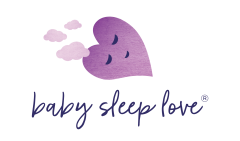
Baby Sleep Love
Certified Sleep Consultant
Parents of newborns often think there’s nothing that can be done about sleep at this age. Spoiler alert: newborns (ages 0-3 months old) are very open to sleep changes. With consistent effort, it’s absolutely possible to establish good newborn sleep habits for life. And when parents invest in establishing these habits from day one, formal sleep coaching or training is often not even needed or needed minimally.

Here are three healthy, age-appropriate sleep habits that you can put into place, beginning from day one:
1. Follow age-appropriate wake windows
After working with thousands of families to gently improve their little ones’ sleep, there’s one evidence-based ‘sleep truth’ that’s been proven over and over.
Learn your child’s age-appropriate wake windows – grab The Better Sleep Bundle for Babies here. It can mean the difference between a well-rested baby that falls asleep easily and one that’s fussing, upset, and seems to *dislike* sleep.
Often the reason why you can’t seem to put your baby down is because you haven’t nailed the timing that works best for them. A wake window is the amount of time your little one can handle being awake in one stretch. Some babies take weeks to develop “sleepy cues” (e.g., yawning). Comparatively, others may appear not to have them at all. Further, after a certain age (usually around 4 months old) these cues are typically not reliable.
Understand your newborn’s optimal wake windows! It can mean the difference between an overtired baby and one who takes restorative naps. One who sleeps in short spurts and one who is progressively sleeping longer stretches.
So, how much awake time can your little one handle? When a baby is first born, it can handle about 45 minutes. At 2 months old, this increases to around 1-1.25 hours. At 3 months old, this increases to around 1-1.5 hours. The Better Sleep Bundle for Babies has detailed schedules that will help you figure out the age-appropriate wake windows for your little one.
2. Create a good habits sleep-conducive environment
A perfectly sleep-conducive environment means your efforts to teach good newborn sleep habits are less likely to be futile. Explicitly, it includes a dark and cool room (between 20-21 degrees Celsius, or 68-70 degrees Fahrenheit), with continuous white/pink noise running. Additionally, it will have a minimalist look to the area in and around your little one’s bed.
Babies sleep more soundly if the area around their crib/bassinet/cradle is fairly minimalist. This means the sleep space is decluttered and free from mobiles, toys, and distracting piles of ‘stuff’ nearby. The continuous use of white noise helps to block out any noise annoyances and helps little ones transition smoothly between their sleep-wake cycles. After a baby’s day/night confusion has resolved, typically by about 2 months of age, use room-darkening shades or blinds. This can be whatever you have on hand (e.g., garbage bags, towels) as well, and is for all naps (that they’re taking at home) and nighttime sleep. Accordingly, this helps to support the production of melatonin, the sleepy hormone, helping your baby to fall asleep and stay asleep more easily.
3. A bedtime routine for newborns
What’s in a bedtime routine? Quite a bit. A routine can help your baby understand what’s expected next…sleep! Babies feel more reassured when you implement a consistent routine that they can easily recognize.
At about 2 months old, a great bedtime routine lasts about 5-10 minutes and subsequently, at 3 months old, it’s around 20-30 minutes. The routine includes calming activities done in approximately the same order every night. A great nap routine is a shortened version of the bedtime routine, lasting about 5 minutes. It’s okay to mix up your routine to include/exclude a bath but try to keep the rest of the routine as consistent as possible from day to day.
Here’s a sample bedtime routine:
- Wash up
- PJs
- Massage
- Bedtime Books and/or Songs
- Sleep phrase (e.g., It’s time for sleep, sweetie)
- Snuggles and into bed
You can create whatever routine works best for your family, but please make sure you have one. It’s incredibly important for helping to support your little one’s smooth transition into sleep.
When to introduce independent sleep
During the newborn stage, you may be helping your baby to fall asleep by bouncing or rocking them in your arms or by cuddling or feeding them to sleep. Once you’ve established these three good newborn sleep habits however, consider moving your little one gently toward more independent sleep. What does this mean? For example, if you are currently bouncing your baby to sleep on an exercise ball, try to first bounce less vigorously, and then progress to just sitting on the ball, then just holding your baby to sleep, and so on. In the newborn stage, this is a gentle, gradual progression towards your little one being able to fall asleep on their own. You can easily adapt this strategy to wherever you are right now with your little one’s sleep.
Want to learn even more about good sleep habits?
In my online newborn sleep program Four Weeks To Better Newborn Sleep, you’ll learn absolutely everything you need to know about newborn sleep, how to establish healthy, independent sleep habits, gently lengthen overnight sleep and find a predictable rhythm to daytime naps, too. It’s packed full of strategies and techniques that are extremely effective for this age group. Hope to see you on the inside!
Join Baby Sleep Love on Facebook and Instagram.
Craving some step-by-step, personalized help with teaching your toddler to fall asleep on their own, and sleep through the night? I’ve got you covered! Take a look at how we can help with our packages here. I work with children up to 6 years old (it’s never too late!).